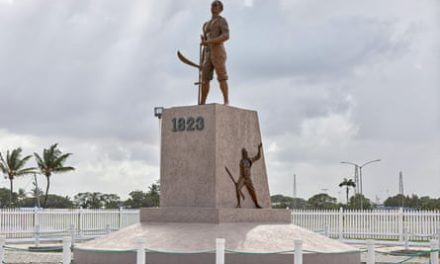When William Wordsworth’s beloved younger brother John died on a ship that sank in rough seas off the coast of Dorset in 1805, the great Romantic poet dealt with his sorrow by writing of the “calamitous” loss: “Sea, Ship, drown’d, Shipwreck – so it came/The meek, the brave, the good, was gone;/ He who had been our living John/ Was nothing but a name.”
John was captain of the East India Company’s largest ship, the Earl of Abergavenny, which sank after hitting rocks shortly after embarking on a trading voyage to China. He was among more than 250 crew and passengers who perished on a bitterly cold February night.

Photograph: The National Trust Photolibrary/Alamy
Now it has emerged that Wordsworth brought himself closer to his brother’s memory by collecting physical reminders of him – antiquities from wrecks and historic ships, according to new research by Dr Sean Kingsley, a British maritime archaeologist.
He was astonished to learn from a little-known 1848 letter, discovered by the explorer Rex Cowan, of “a hitherto unrecognised effect” of the sinking of the Abergavenny: “This gives a new insight into how Wordsworth dealt with the death of his brother. By collecting these artefacts, William found a way to keep the memory of John alive and deal with the psychological scars.
“Until now, no one has realised what psychological crutches Wordsworth leaned on to desperately keep John’s memory alive.”
John was a shy and gentle soul. Nothing gave him greater pleasure than wandering among the hills around the Lake District – just as William was inspired by its dramatic landscapes. Grasmere had inspired some of his greatest poetry, including “I Wandered Lonely as a Cloud”.
John, who was known to his shipmates as “the philosopher”, had hoped to make a fortune through the trading voyage and share the proceeds with William, to enable him to pursue his poetry.
William was devastated by his brother’s death, writing that he would “never forget him” and that “his eye for the beauties of nature was as fine and delicate as ever poet or painter was gifted with”.

In the letter, he thanks an unnamed woman for a present of a box made from the wreck of the Royal George, a Royal Navy warship that sank off Spithead, Hants, in 1782. He adds that he owns another wooden box made from timbers of the wreck of the Royal William built in 1719, and he also had a walking stick made from wood and copper from the Royal George.
Kingsley is the founding editor of Wreckwatch magazine, whose September issue will feature the latest research.
He writes that Commander Wordsworth’s East India Company charter was heading out on an 18-month voyage to Bengal and China. “The voyage never got going and was its own poetic tragedy,” he says. “Shipboard conditions were poor. The trader had hoped to set off on 1 February 1805, one of five ships in an East Indiamen fleet, after being delayed by a heavy gale. The delay was the ship’s undoing. In hard squalls and heavy swell blowing on 5 February, the Abergavenny struck the Shambles Bank.”
A lead seal embossed with the East India Company logo is among some 2,000 recovered artefacts.
Join the exciting world of cryptocurrency trading with ByBit! As a new trader, you can benefit from a $10 bonus and up to $1,000 in rewards when you register using our referral link. With ByBit’s user-friendly platform and advanced trading tools, you can take advantage of cryptocurrency volatility and potentially make significant profits. Don’t miss this opportunity – sign up now and start trading!







Recent Comments